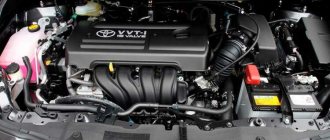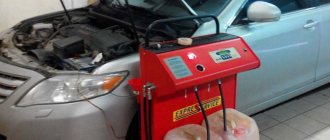- home
- Brands
- Toyota
04.07.2020
Toyota Prius is the first mass-produced hybrid car produced since 1997. It is a five-door hatchback equipped with a gasoline engine and an electric motor. The Prius has won many automotive awards thanks to its original design, environmental friendliness and fuel efficiency. The car is widely distributed in Japan, North America and Europe - it was in these regions that it was recognized as “Car of the Year”. In addition, for the Prius model, Toyota received the UNEP award from the United Nations for the development of environmentally friendly transport. Prius was sold on the Russian market from 2009 to 2019.
Toyota Prius engine oil change period
The manufacturer recommends changing the engine oil every 10 thousand km, otherwise dirt deposits may form and the engine will be subject to premature wear. The specified interval is preferable for ideal urban or suburban operating conditions - with a gentle load, and without sudden starts and braking. But such conditions are practically unrealistic, and besides, the effect of beneficial additives in any oil ends after 7-8 thousand km. Therefore, if signs of deterioration in oil quality are detected, it is advisable to reduce the replacement period by 2000 km.
Step-by-step description of oil change
Changing the oil in the third generation Toyota Prius is carried out in a certain sequence. On a cold engine it is thick, so it will drain worse. As a preparatory step before replacing, it is better to warm up the internal combustion engine - the oil will become thinner and drain better. To get to the drain hole, the car must be raised. A trestle or jack is suitable for this. The drain bolt is hidden behind the service hatch, which will need to be removed. Another option for accessing it is to drive into the pit.
Under the hood of Toyota Prius 30
Don't forget about precautions. Before lifting the car with a jack, you should put supports under the rear wheels or use the parking brake (handbrake). A procedure that prevents the formation of a vacuum will help speed up the emptying of the system. You just need to remove the cap from the filler neck and pull out the dipstick to measure the oil level.
The next stage is the direct drainage of used oil. A container of the appropriate volume is installed under the drain hole, the drain bolt is unscrewed with a number 14 wrench (or a ratchet with a 14 head). Because the car was warming up during the preliminary stage, the oil in the Prius engine became hot. When unscrewing, you need to be careful not to get burned.
Under the hood of the Prius 10
While the lubrication system is draining, assess the condition of the washer. If it is deformed, you should install a new one (original Toyota washer number 90430-12031). Before unscrewing the drain bolt, it is better to check if you have at least one washer in stock. As soon as the lubricant stops leaking, the bolt and washer are screwed into place. It is important to check whether the bolt is securely tightened so that the oil poured into the internal combustion engine does not leak out through the hole in the crankcase pan.
Changing the oil in a Toyota Prius 30 involves installing a new filter element. The Toyota part number for the Prius is 04152-YZZA6. You can also use analogues, for example the following:
- Filtron OE 685/2;
- Bosch F 026 407 091;
- Wix 57064;
- Fram CH10358ECO.
Under the hood of the Prius XW20
The filter element is located behind the oil pan closer to the right side of the car, and its cover faces the left side. The container containing the oil drained from the engine should be moved under the filter. The cover is unscrewed using a key, also called a puller. After removing the old filter element and sealing ring, new ones are installed in their places. The rubber ring is lubricated with engine oil. When tightening, you do not need to use a lot of force, otherwise the sealing ring will be damaged and the filter will leak.
Toyota Prius XW20 after update
The removed service hatch is mounted in place, and the car is lowered using a jack. New oil is poured into the Prius's internal combustion engine through the neck, into which it is better to insert a funnel. You should focus on the volume of the lubrication system. After this, the engine starts and turns off after a couple of minutes. After allowing the oil to drain into the oil pan, you need to check its level with a dipstick. If the oil drop is located closer to the bottom mark, add more. The best option is just below the top mark of the oil dipstick.
How much oil to fill in a Toyota Prius engine
First generation (XW10, model year – 1997-2003)
The first generation Toyota Prius had no competitors, and thanks to this it quickly became popular in many developed countries. Thus, this is the first mass-produced model with a hybrid installation, which at that time included a 58-horsepower internal combustion engine and a 40-horsepower electric motor powered by a battery. This unit consumed an average of 5.7 liters per 100 km. This figure remained almost unchanged after the 2000 restyling, when engine power was increased.
Also read: Engine oil for Volvo S40 engine
Gasoline engines (1997-2003)
1.5 1NZ-FXE (58 hp), oil volume - 3.9 liters, tolerance and viscosity - API SM, SG/SJ, ILSAC GF-3; 5W-30, 10W-30.
Second generation (XW20, model year – 2003-2011)
In the second generation, the Prius began to look like a full-fledged hatchback (the previous model had the appearance of a sedan due to a slightly elongated trunk). At the same time, thanks to design changes, aerodynamics have improved and fuel consumption has been reduced, making it possible to install a more powerful hybrid engine. Its total output increased to 110 hp. With. As with its predecessor, the engine was still coupled with a CVT.
Gasoline engines (2003-2011)
1.5 1NZ-FXE (76-110 hp), oil volume - 3.9 liters, tolerance and viscosity - API SM, SG/SJ, ILSAC GF-3; 5W-30, 10W-30.
Third generation (XW30, model year – 2009-2015)
From a design point of view, the 2009 Prius can be considered a deep modernization of the previous model, given the similar body shape. At the same time, the hatchback began to look sportier due to a less pronounced radiator grille, new bumpers and more technologically advanced headlights. The interior has retained simple solutions without design frills, but with excellent ergonomics. The second generation Prius was equipped with a new Hybrid Synergy Drive hybrid system, including a 99-horsepower 1.8 engine and an 82-horsepower electric motor. In combined driving mode, the installation developed 136 hp. s., and fuel consumption in the combined cycle was 4 l/100 km.
Gasoline engines
1.8 2ZR-FXE (99 hp), year of manufacture. – 2009-2016, oil volume – 4.2 liters, tolerance and viscosity: API SM, SM/EC, ILSAC GF-4; 0W-20, 5W-20.
Fourth generation (XW30, model year - since 2015)
The 2015 Toyota Prius looks more like a sedan in appearance, which evokes associations with the very first Prius, although in fact this design concept was first adopted by the Toyota Mirai, the first mass-produced car with a hydrogen engine. Moreover, the 4th generation Prius looks like a smaller version of the Mirai. In technical terms, the car has been modernized - the hybrid installation still works with a CVT, and its components are a 1.8-liter 98-horsepower internal combustion engine and a 72-horsepower electric motor. In some countries, an all-wheel drive E-Four modification is available, in which the rear wheels are driven by an additional electric motor. In addition, there is also the Prius Prime version, which has a modified design and the ability to recharge from a home electrical outlet.
Also read: Motor oil for the YaMZ-536 engine
Gasoline engines (since 2016)
1.8 2ZR-FXE (98 hp), year of manufacture. – 2009-2016, oil volume – 4.2 liters, tolerance and viscosity: API SN, SM/EC, ILSAC GF-5; 0W-20, 5W-20, 5W-30.
How often to change the lubricant in a Prius engine
According to the maintenance regulations for Toyota Prius cars, the lubricant in the engine must be changed every 10 thousand kilometers or once a year. Under severe operating conditions, the replacement period is reduced by half (every 5 thousand km or every six months).
In parallel with changing the contents of the lubrication system, a new oil filter is installed. To carry out an oil change on your Prius 30, you need to know how much oil a particular engine requires. In this case we are talking about the 2ZR-FXE engine, the filling volume of which is 3.9 liters (including a filter of 4.2 liters). Before you start work, you need to prepare everything you need.
Required tools and materials
To complete the work you will need:
- oil (originally Toyota Genuine Motor Oil is used, but an equivalent that meets the viscosity and quality requirements is suitable);
- oil filter for Prius 30;
- jack and supports (heels) for wheels;
- 14mm wrench (or ratchet with head);
- a special 24mm wrench for unscrewing the filter cover;
- container for draining (more than 5 liters);
- funnel.
Under the hood of the Prius 50
What kind of oil to fill in the Toyota Prius engine
Original
The branded motor oil for Toyota Prius is Toyota Motor Oil with a viscosity of 5W-30, or you can use 10W-40 or 15W-40 for all-season use. In the winter season it is better to fill in 0W-40 or 5W-40, and in the summer a viscosity of 20W-40 or 25W-40 is recommended.
Unoriginal
When choosing an analogue, you need to pay attention to the additional characteristics of the oil: for example, suitable API SM approvals for the 2010 Prius, as well as API SM for the 2011-2015 models. Viscosity is selected depending on the time of year or all-season use. So, 20W-40 or 25W-40 is suitable in summer, 0W-40 or 5W-40 in winter, and 10W-40 or 15W-40 is the best choice for all-season use. For example, you can choose the following products:
- Mobil Super 3000 X1 Formula FE 5W-30
- Idemitsu Zepro Eco Medalist 0W-20
- Idemitsu Zepro Touring 5W-30.
Prius planetary gearbox design
The planetary transfer mechanism has the most complex design in the Toyota Prius drive. It ensures a systematic distribution of forces from the internal combustion engine and the electric motor. The planetary system allows you to automatically connect the gasoline power unit when the situation requires it. Also disconnect the internal combustion engine from the drive mechanism, leaving it to work exclusively with the generator.
Box and motor generator
The design of the planetary transfer mechanism is made in such a way that the gasoline power unit is not directly connected to the wheel drive. The motor participates in the rotation of the wheels at those moments when the optimal operating mode of the internal combustion engine is achieved. This applies to crankshaft speed and machine speed. This contributes to the release of only part of the energy of the internal combustion engine to transmit torque to the wheels. For the Toyota Prius hybrid installation, according to operational data, the internal combustion engine operates in optimal mode at two or more thousand revolutions per minute.
Toyota Prius transmission of different generations
An important task of a gasoline unit is to ensure the operation of a generator to generate electrical energy. When driving the Prius at low speeds or in traffic jams, the hybrid switches on electric traction, which is provided by the capacity of the battery. To accelerate the car, additional electricity will be used, obtained as a result of the integrated operation of the internal combustion engine and generator.
Toyota Prius 30/Prius 30 Knowledge Base
13 years on the site user #136016
LIST OF ORIGINAL SPARE PARTS AND CONSUMABLES
Engine oil Toyota SAE 0W-20 Advanced Fuel Economy Class: API SN; ILSAC GF-5. Manufacturer: JX Nippon Oil & Energy Corporation (Made in Japan) 08880-10505 - 4 liters (tin) Manufacturer: ExxonMobil Corporation (Made in Sweden) 08880-83264 - 1 liter 08880-83265 - 5 liters
Engine oil Toyota SAE 0W-30 Synthetic Class: ACEA A5/B4; API SL. Manufacturer: ExxonMobil Corporation (Made in EU) 08880-80366 - 1 liter 08880-80365 - 5 liters
Engine oil Toyota SAE 5W-40 Synthetic Class: ACEA A3/B3, A3/B4; API SN/SM, CF. Manufacturer: ExxonMobil Corporation (Made in EU) 08880-80376 - 1 liter 08880-80375 - 5 liters
Toyota SAE 5W-30 engine oil (mineral) Class: API SN/CF. Manufacturer: JX Nippon Oil & Energy Corporation (Made in Japan) 08880-83322 - 4 liters 08880-83323 - 20 liters
In Toyota and Lexus car engines, it is necessary to use motor oils of a quality not lower than that specified in the technical documentation and the “Owner's Guide” according to the classification of API (American Petroleum Institute) or ACEA (Association of European Automobile Manufacturers). To ensure reliable engine starting and best oil pumpability at subzero outside temperatures, the viscosity of the engine oil (SAE) must correspond to the operating conditions of the vehicle. Having a wide range of viscosity-temperature characteristics, Toyota SAE 0W-30, Toyota SAE 5W-40, Lexus SAE 0W-30, Lexus SAE 5W-40 motor oils can be used as a replacement for motor oils with viscosity (SAE) 0W-20, 5W -20, 5W-30, 10W-30, 15W-40, 20W-50.
Engine oil filter
04152-37010 - production: Thailand and Japan 04152-YZZA6 - production: Thailand The characteristics and quality of both filters are identical
non-original - I recommend Meyle 30143220005
Engine oil drain plug gasket
90430-12031 - production: Japan 90080-43037 - production: Portugal
Gearbox oil drain and filler plug gasket
90430-18008 - production: Japan
Engine air filter
17801-37021 - Denso, made: Japan (
Non-original - I recommend Japan Parts FA-2000s
)
Spark plugs
90919-01253 - Denso SC20HR11, 1 pc., made: Japan
Air conditioning system air filter
87139-30040 - made: Japan 87139-02020 - made: Japan 87139-YZZ16 - made: France 87139-50060 - carbon, made: Japan Denso DCC1009 - antibacterial, made: Japan (
Non-original - I recommend carbon NipParts J1342027
)
Coolant for engine and hybrid system
Antifreeze Super Long Life Coolant (SLLC) 08889-80072 - 5 liters, Pre-mixed (up to -35°C, not diluted with water), production: EU 08889-80140 - 1 liter, Concentrated (below -35°C, not diluted water), production: EU 08889-01005 - 2 liters, Concentrated (diluted with water in the proportions indicated on the package), production: Japan
Hybrid transmission oil
Automatic transmission fluid WS 08886-81210 - 1 liter, production: EU 08886-02305 - 4 liters, production: Japan 00289ATFWS - 0.946 liters, production: USA
Brake pads
04465-47060 — front, set, ADVICS, made: Japan 04465-47070 — front, set, ADVICS, made: Japan 04465-0W141 — front, set, Textar, made: Germany 04466-47020 — rear, set, Akebono, made : Japan 04466-47030 — rear, set, Akebono, made: Japan 04466-47080 — rear, set, Akebono, made: Japan
(Non-original - I recommend Textar 2461001 - rear, 2445101 - front
)
Not TRW
Brake discs
43512-47040 — front brake disc (1 pc.) 43512-47050 — front brake disc (1 pc., more subject to wear) 42431-12310 — rear brake disc (1 pc.)
(Non-original - I recommend TEXTAR 92225003 - front, 92224003 - rear
)
Not TRW
Brake Fluid
08823-80004 - DOT 5.1, 1 liter, production: EU 08823-80112 - DOT 4, 1 liter, production: EU 08823-80111 - DOT 4, 0.5 liters, production: EU
Lubricant for brake caliper and piston guides
Rubber Grease 08887-01206 - 100 g, made: Japan 08887-83010 - 100 g, made: Japan
Lubricant for anti-squeak brake plates
Disk Brake Grease 08887-80609 - 50, made: Japan
Fuel pump housing with filter assembly
for vehicles of the European and Japanese markets 77024-75010 77024-47090
Blades
Denso wiper blade - DU-065L; Denso windshield wiper blade - DU-045L;
Hub assembly with bearing
43550-47011 front left or right 42450-47040 rear left or right
If the noise is annoying, make sound insulation - for example, STP
Source
| Toyota Motor Oil SN 0 W-20 4 liters Article: 08880-10505 1 liter Article: 08880-10506 Approved analogues with approval Average price: 2970 rubles 1 liter Article: 152622 Average price: 800 rubles | Petro-Canada Supreme Synthetic W-2 4 liters Article: 08880-09105 1 liter Article: 08880-09106 Average price: 680 rubles |
| Toyota Motor Oil SM 0W-20 4 liters Article: 08880-09205 1 liter Article: 08880-09206 Average price: 550 rubles | Lukoil Lux 5W-30 API SL/CF 4 liters Article: 196256 Average price: 1380 rubles 1 liter Article: 196272 Average price: 400 rubles |
What consumables and how much fluid to fill in Toyota Prius 2-3 generations
Toyota Prius is a hybrid passenger car. Capable of operating not only gasoline, but also electric engines. The main advantage is low fuel consumption. It consumes only 4 liters of gasoline per 100 km. Buyers are attracted by the practical and spacious interior, ease of operation and good sound insulation.
Priuses 20-30 bodies are quite reliable. Its systems and units can last a long time if they are maintained correctly and in a timely manner.
What happens to the car if there is not enough oil in the automatic transmission?
If the automatic transmission oil on a Prius is not changed on time, the transmission quickly fails. This threatens loss of control on the road and increases the risk of the car being involved in an accident. If an automatic transmission breaks down, repairs will be lengthy and expensive. To avoid this, the car owner needs to monitor the level and quality of the lubricant. Signs of a low level of technical fluid in the automatic transmission are:
- Moving the machine jerkily;
- Strong vibration when driving;
- Problems with gear shifting;
- A clicking sound when the unit is operating due to increased friction of parts.
In turn, if the oil is not only low, but its service life has also expired, the car owner will detect this by the following signs:
- The appearance of a heavy smell of burning and soot;
- The active lubricant thickens and loses viscosity, turning into a sticky heterogeneous mass;
- The color of the technical fluid changes. It becomes almost black and opaque.
To maintain the Toyota Prius automatic transmission in satisfactory working condition, it is necessary to periodically check the quality and level of the oil. For a quality check, you should compare the minimum amount of the substance used with a similar new liquid. To check the amount of lubricant, use a dipstick.










